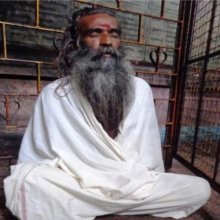Immersion, Immersed: 2 definitions
Introduction:
Immersion means something in Hinduism, Sanskrit. If you want to know the exact meaning, history, etymology or English translation of this term then check out the descriptions on this page. Add your comment or reference to a book if you want to contribute to this summary article.
Images (photo gallery)
In Hinduism
Yoga (school of philosophy)
Source: ORA: Amanaska (king of all yogas): A Critical Edition and Annotated Translation by Jason Birch1) Immersion (in the fourth state and beyond) is denoted by the Sanskrit term Samāveśa, according to Kṣemarāja’s Pratyabhijñāhṛdaya.—Accordingly, while discussing easy methods of Yoga practice: “[...] By apprehending the absence of thought because there is no thinking at all, one becomes full of the perception of a knowing subject's own consciousness devoid of defects such as the body and so on, and one soon obtains immersion (samāveśa) in the fourth [state] and that beyond the fourth [state], [an immersion] whose expansiveness is [always] opening out”.
2) (Becoming) Immersed (in the space between the eyebrows, etc.) is denoted in the Sanskrit language as Magna, according to the according to the Amaraughaprabodha (6): a short 13th century treatise on Yoga attributed to Gorakṣanātha which teaches the fourfold system of yoga (Mantra, Laya, Haṭha and Rāja).—Accordingly, “That which causes the gains of the six acts [of magic] does not manifest through Mantra; the mind does not become immersed (magna) in the [space between] the eyebrows, [the tip of] the nose and so on, by some method †[like an insect]†; and the Yogins’ breath does not go into the base [of the spine] because of various practices, without the respected Rājayoga, which is an abode of splendour full of eternal bliss”.

Yoga is originally considered a branch of Hindu philosophy (astika), but both ancient and modern Yoga combine the physical, mental and spiritual. Yoga teaches various physical techniques also known as āsanas (postures), used for various purposes (eg., meditation, contemplation, relaxation).
Pancaratra (worship of Nārāyaṇa)
Source: Shodhganga: Expiatory Rites in Keralite Tantra (p)Immersion (in Sanskrit: Avagāha) refers to one of the seven types of Bimbaśuddhi (purificatory expiations for the idol) (employed for averting impurities), according to the Viṣṇusaṃhitā: an important Tantric work of Kerala authored by Sumati, composed between 11th and 14th century divided in to 30 chapters (paṭalas).—The expiatory rites are elucidated in the 25th chapter. Viṣṇu-saṃhitā suggest seven kinds of purification for averting these impurities. In addition to these another seven types of purificatory expiations for the idol (biṃbaśudhi) are elucidated in this text [e.g., Immersion (avagāha)] [...]. The text further recommended various Mantras to be used for expiations. [...]

Pancaratra (पाञ्चरात्र, pāñcarātra) represents a tradition of Hinduism where Narayana is revered and worshipped. Closeley related to Vaishnavism, the Pancaratra literature includes various Agamas and tantras incorporating many Vaishnava philosophies.
See also (Relevant definitions)
Query error!
Full-text (+607): Nimajjana, Magna, Nimagna, Avagahana, Majjana, Avagadha, Pramagna, Rahugrasa, Samnimagna, Gahati, Masj, Avagahita, Vigadha, Vilina, Opilapeti, Paripluta, Jalamagna, Opilapita, Sammagna, Vrudita.
Relevant text
Search found 240 books and stories containing Immersion, Immerse, Immersed; (plurals include: Immersions, Immerses, Immerseds). You can also click to the full overview containing English textual excerpts. Below are direct links for the most relevant articles:
World Journal of Pharmaceutical Research
In vitro study of ionic release in Co/Cr and Ni/Cr alloys in various pH. < [2017: Volume 6, November issue 14]
Aging and immersion effects on denture lining surface properties < [2019: Volume 8, March issue 3]
Eco-friendly Portulaca quadrifida extract as carbon steel inhibitor. < [2018: Volume 7, March special issue 6]
Vaisheshika-sutra with Commentary (by Nandalal Sinha)
Sūtra 9.2.7 (Dream, how produced) < [Chapter 2 - (? Inferential cognition)]
International Ayurvedic Medical Journal
Effect of jala shirodhara in anidra w.s.r to insomnia – a case series < [2023, Issue 06, June]
Evaluation of peripheral and central analgesic efficacies of ayurvedic new formulation for amavata disease in animal mod-el through writhing test and tail -flick immersion test in micemodel < [2023, Issue 10. October]
Case control observational study of saam jivha as a lakshan in annavahasrotoduushti w.s.r. to saliva ph test < [2017, Issue XII, december,]
Social Folk customs of the Sonowal and Thengal Kacharis (by Suravi Gohain Duwarah)
Part 1.4 - Description of Sua Utua Sabah < [Chapter 4 - Social folk customs of the Thengal Kacharis]
Part 1.16 - Description of Bhur Utuwa Sabah < [Chapter 3 - Social folk customs of the Sonowal Kacharis]
Vinaya Pitaka (1): Bhikkhu-vibhanga (the analysis of Monks’ rules) (by I. B. Horner)
Shiva Purana (by J. L. Shastri)
Chapter 36 - Installation of Śiva < [Section 7.2 - Vāyavīya-saṃhitā (2)]
Chapter 3 - Kāma is cursed but blessed later < [Section 2.2 - Rudra-saṃhitā (2): Satī-khaṇḍa]
Chapter 17 - The greatness of Jyotirliṅga Mahākāla < [Section 4 - Koṭirudra-Saṃhitā]
Related products
(+20 more products available)








